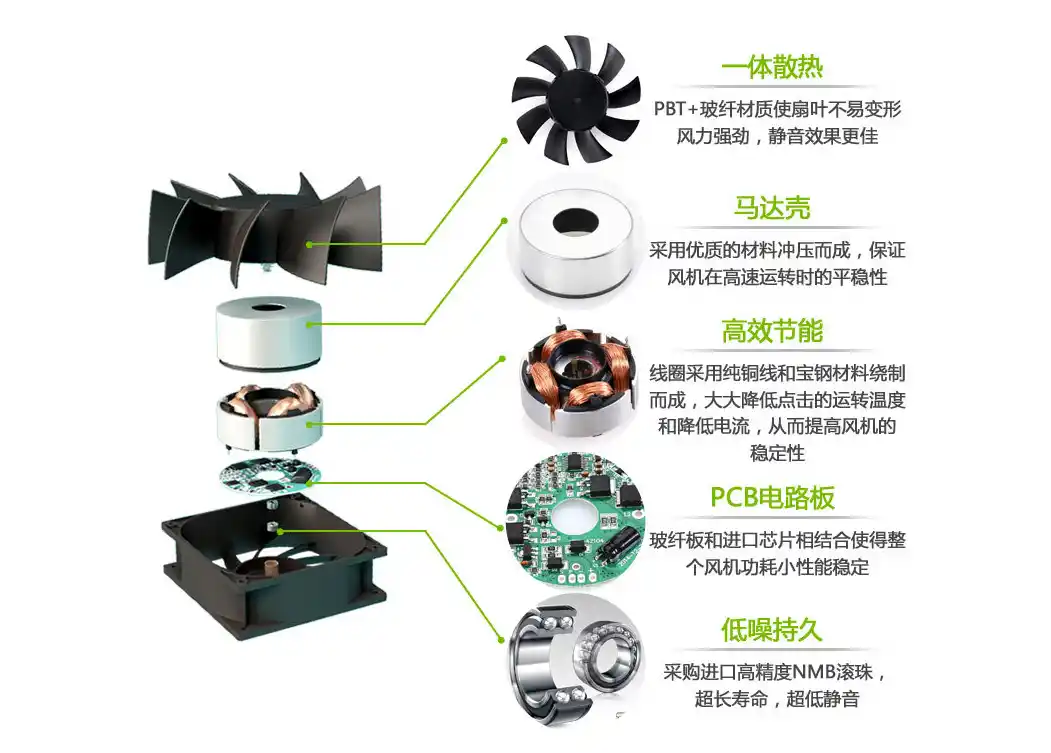Cooling fans are widely used in both daily life and industrial applications, playing a crucial role in cooling electronic devices, servers, power systems, and more. However, many users have limited knowledge of their technical specifications and tend to focus only on size or RPM while overlooking other critical parameters. These factors directly impact fan performance, lifespan, and suitability for specific applications. Understanding and evaluating these indicators is essential when selecting or designing a cooling fan.
1. Airflow (CFM/m³/min)
Airflow refers to the volume of air a fan moves per unit time, typically measured in CFM (cubic feet per minute) or m³/min (cubic meters per minute). It is a key indicator of cooling efficiency—the higher the airflow, the more heat is dissipated. However, airflow depends on factors such as fan size, blade design, and speed. Choosing the right airflow should align with the cooling requirements of the equipment.
2. Static Pressure (mmH₂O/Pa)
Static pressure measures a fan's ability to overcome air resistance, expressed in mmH₂O (millimeters of water) or Pa (Pascals). There is an inverse relationship between airflow and static pressure—fans with high airflow generally have lower static pressure, and vice versa. For open-air applications with low resistance, high-airflow fans are preferable. In contrast, for applications with restricted airflow, such as server cooling systems with dense heat sinks or dust filters, fans with higher static pressure are necessary.
3. RPM (Revolutions Per Minute)
RPM indicates the number of rotations the fan blades complete per minute. Higher RPM generally results in increased airflow and static pressure but may also lead to higher noise levels and power consumption. Many high-end cooling fans feature PWM (Pulse Width Modulation) control, which dynamically adjusts speed based on temperature, optimizing cooling efficiency while minimizing noise.
4. Vibration
Vibration occurs due to mechanical imbalances or external factors and may originate from:
- Impeller imbalance
- Bearing wear or poor lubrication
- Manufacturing tolerances
Excessive vibration can shorten the fan's lifespan and may even cause resonance or damage to nearby components. High-quality fans incorporate precision dynamic balancing technology and premium bearings (such as fluid dynamic bearings or dual ball bearings) to minimize vibration.
5. Noise Level (dB)
Fan noise is measured in decibels (dB) and originates from:
- Bearing friction
- Airflow turbulence from blade movement
- Electromagnetic noise from the motor
Noise is a critical factor in applications such as medical devices, office environments, and home electronics, where quiet operation is essential. Advanced fans feature optimized blade designs, low-noise motor structures, and intelligent speed control to reduce noise levels.
6. Abnormal Noise
Abnormal noises, such as grinding, buzzing, or clicking, indicate potential mechanical faults, which may result from:
- Worn-out or dry bearings
- Loose motor windings or improper assembly
- Blade obstructions or foreign objects inside the fan
Reliable fan manufacturers use high-precision machining and strict quality control to prevent such issues.
7. Lifespan (MTTF/L10)
Fan lifespan is measured using MTTF (Mean Time to Failure) or L10 (time at which 90% of fans remain operational). The bearing type significantly affects lifespan:
- Sleeve Bearings: ~30,000 hours
- Ball Bearings: ~50,000-70,000 hours
- Fluid Dynamic Bearings (FDB): ~100,000 hours
Longer-lasting fans reduce maintenance costs, making them ideal for industrial automation, servers, and telecom equipment that require continuous operation.

8. Voltage & Power Consumption
Cooling fans operate at standard voltages such as 5V, 12V, 24V, and 48V. Selecting the correct voltage ensures compatibility with the system. Power consumption (W) is also an important factor, especially in data centers and telecom base stations, where energy efficiency is a priority.
9. Protection Features
High-quality cooling fans come with various protective features to enhance reliability and safety:
- Reverse Polarity Protection: Prevents damage due to incorrect wiring
- Locked Rotor Protection: Automatically shuts down if the fan is blocked
- Overload Protection: Prevents motor burnout due to excessive current
- IP Ratings for Dust & Water Resistance: e.g., IP55, IP68 for harsh environments
Conclusion
The performance, noise level, lifespan, and application suitability of a cooling fan depend on its technical specifications. Choosing a fan based solely on size or RPM may lead to suboptimal results. Instead, a comprehensive evaluation of airflow, static pressure, noise, and other key parameters ensures the best performance for the intended application.
As a manufacturer with 24 years of experience, Ruiapple Electric provides high-efficiency, low-noise, and long-lifespan cooling solutions, helping customers achieve optimal thermal management.






